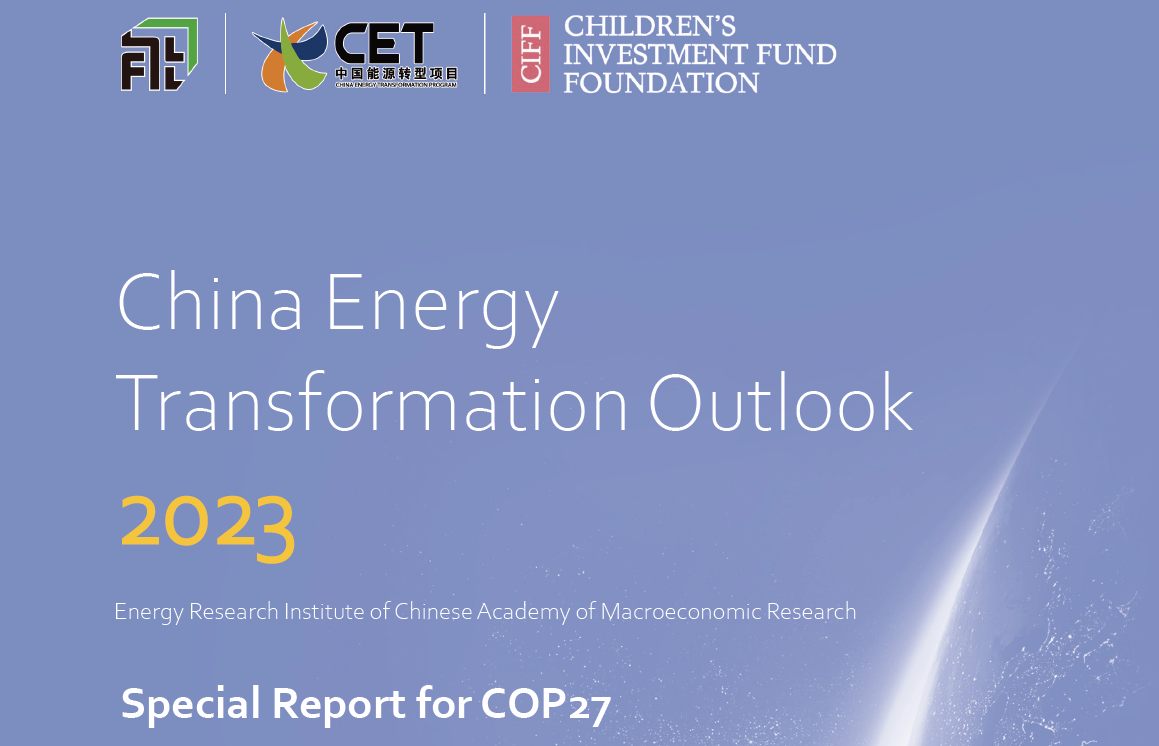China Energy Transformation Outlook 2023: Special Report for COP27
The low- and zero-emission energy transformation built to ensure stable economic and social development and people’s livelihoods is the key to achieving climate goals and driving a comprehensive green and low-carbon transition of the economy and society. However, the changes in the global energy landscape in recent years and the energy transformation practices of various countries have made us acutely aware that energy supply chain stability and energy system resilience are essential issues that cannot be ignored in energy system transformation.
Since establishing an energy partnership in 2005, China and Denmark have engaged in extensive intergovernmental cooperation in the energy sector. Both countries believe in green growth and are committed to green energy transformation. The China Energy Transformation Outlook 2023: COP27 Special Report provides an in-depth summary and discussion of the results of the energy transformation in both China and Denmark and their respective efforts to address the challenges of climate change.
By drawing on the successful experiences of China and Denmark in green transformation, the “China Energy Transformation Programme” seeks to comprehensively explore the new opportunities and challenges brought by current changes in the world to the prospect and path of energy transformation, identify and analyse the inadequacies and gaps in the energy transformation, and propose some countermeasures for optimizing China’s energy transformation path.
The China Energy Transformation Outlook 2023 report will be available early next year.
Key findings of the COP27 Special Report
- The global climate change situation is becoming increasingly severe, and CO2 emissions continue to increase. The deep restructuring of the world energy supply and demand map, the complex international environment and the marked increase in instability and uncertainty in the energy market have added to the difficulty of the global energy transition. Nevertheless, the global consensus to move towards carbon neutrality is growing amidst the uncertain situation. New topics, such as the resilience of energy systems, have sparked the attention of governments and industries worldwide.
- The global climate change situation is becoming increasingly severe, and CO2 emissions continue to increase. The deep restructuring of the world energy supply and demand map, the complex international environment and the marked increase in instability and uncertainty in the energy market have added to the difficulty of the global energy transition. Nevertheless, the global consensus to move towards carbon neutrality is growing amidst the uncertain situation. New topics, such as the resilience of energy systems, have sparked the attention of governments and industries worldwide.
- China is steadfastly promoting energy transition as the world’s largest developing country and largest energy consumer. China has increased its efforts to develop clean energy, and renewable energy has entered a phase of high proportion and large-scale development. Coal power plants are gradually becoming more efficient with less air pollution and play an essential role in ensuring energy security in China in its current setup. Meanwhile, China has paid particular attention to enhancing its energy system’s regulation and reserve capacity, and the construction of a modern energy system is accelerating. Regarding energy consumption, China’s energy efficiency has continued to improve, low-carbon technology innovation has accelerated, and green lifestyles are developing faster. Key regions such as the Yangtze River Economic Belt, the Guangdong-Hong Kong-Macao Greater Bay Area, the Yangtze River Delta, and the Yellow River Basin promote green and low-carbon development and energy transformation combining local realities, forming a new regional map of promoting the energy transformation in China.
- Denmark is internationally recognised as a leading pioneer in energy transformation and climate change mitigation. Through consistent efforts such as developing legislation, implementing policies, conducting pilot projects and demonstrating technologies, Denmark has built a world-class green energy system, which provides improvements to everyday life and greener, more affordable energy while ensuring the security of supply. Thereby, Denmark has achieved significant CO2 reductions, solid economic growth and increasing energy efficiency throughout the past four decades through setting ambitious climate targets, large-scale deployment of wind power (both offshore and onshore), promoting electrification of the end-use sectors, adopting green heating based on district heating and heat pumps, together with the prospective development of green fuels from electricity (Power-to-X) and CCUS technologies,
- Both China and Denmark have ambitious goals for reducing CO2 emissions from the energy sector, and both have long-term visions for the future carbon-neutral energy system. Even though the two countries have very different characteristics, many energy transformation elements are the same. Energy efficiency improvement on the demand side is needed to ensure that the pace of supply-side deployments can keep up and sustain the required economic growth. Green energy supply – technological progress and cost reduction make RE able to provide clean energy in bulk, mainly through renewable electricity, and green heating will replace fossil-fuel heating. Electrification will support the phase-down of fossil fuels in industry, transport and building sectors, in conjunction with the decarbonisation of the electricity supply. Hydrogen becomes a vital energy carrier based on sufficient and economical green electricity for hydrogen production, and it provides green energy for end sectors that have difficulty reducing emissions. Green hydrogen, combined with captured carbon, allows for the production of fuels for difficult-to-abate sectors such as heavy transport, shipping, and aviation. Sequestration of CO2 creates the backstop or last resort option, which enables negative emissions by storing CO2 in carbon sinks. Negative emissions can compensate for a modest level of emissions still in the system to ensure carbon neutrality. Finally, drivers for transformational change are needed, including long-term planning, concrete innovation and implementation strategies and cooperation across stakeholders, nationally and internationally.
- The energy transition must be a global action. China’s energy transition affects domestic green and low-carbon development and profoundly impacts global climate goals. Achieving net-zero emissions globally is a critical and daunting goal that requires close collaboration between countries worldwide.
- Integrating international experiences, the China Energy Transformation Outlook 2023, to be released in spring 2023, is one good example of international cooperation. It will provide insights into the development required for China’s energy sector to achieve net-zero carbon emissions in the future. The report sets out three development scenarios intending to provide more detailed and quantitative analysis, as well as more in-depth thinking, for China to understand the timeline and roadmap for its future energy transformation and to deal with the relationship between energy transformation and energy security in an integrated manner, through the analysis and comparison of different scenarios.
Please download the English version of the COP27 Special Report below:

